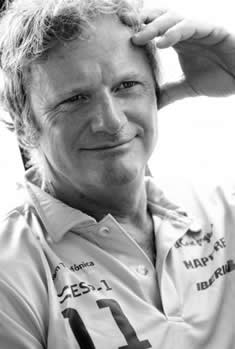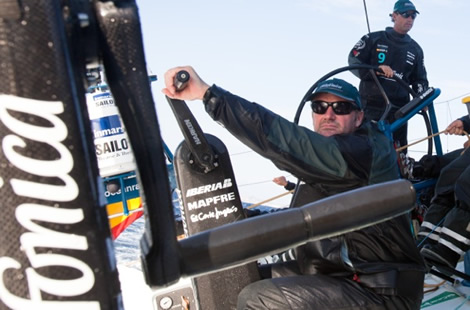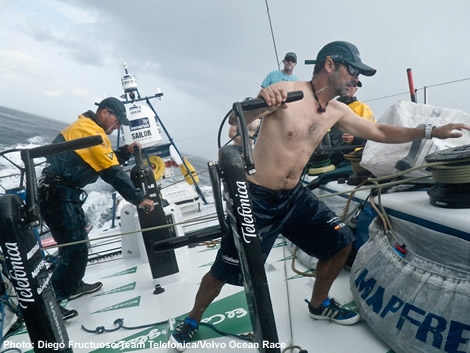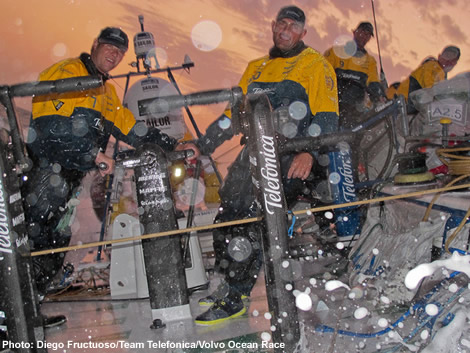Neal McDonald on the Volvo Ocean Race
With three leg wins under their belt and the first third of the 2011-12 Volvo Ocean Race race now completed, the Iker Martinez-skippered Telefonica is proving to be the class act in this, the team’s third attempt to win the fully crewed round the world race.
Tomorrow action in the Volvo Ocean Race resumes with the in-port race off Sanya with the start of leg four to Auckland, New Zealand on Sunday. At 5,220 miles this takes the boats once again back across the Equator and into the Southern hemisphere and will be the longest leg the boats have sailed on their own bottoms since the first leg from Alicante to Cape Town.
For the Telefonica sailing team, they have been fortunate to have a few days off and Watch Captain Neal McDonald managed to fly home to the south of France to spend time with wife Lisa (who skippered Amer Sport Two in the 2001-2 race) and their kids over half term.
 “It was nice to be cold for a change,” admits McDonald, who personally hasn’t been enjoying the sweltering heat that in particular featured on the last leg from the Maldives to Sanya, much of it spent sailing east at 5-10°N.
“It was nice to be cold for a change,” admits McDonald, who personally hasn’t been enjoying the sweltering heat that in particular featured on the last leg from the Maldives to Sanya, much of it spent sailing east at 5-10°N.
Meanwhile Telefonica has been left in the hands of her capable shore crew, led by Horatio Carabelli, who in the last two races sailed with Torben Grael on Brasil 1 and then the winning Ericsson 4. “We have got a very very good shore crew, whom we have had for nearly three years – a long time,” says McDonald. “We did a lot of sailing in the old boat with this crew and a lot of the shore crew were with Telefonica Blue before. So we are very lucky. We have got some great guys and with Horatio in the lead of that team, we are very comfortable to leave the boat in their hands.”
However in addition to the tight schedule for this round the world race there are limitations on what teams can and can’t do in terms of refitting their boats in stopovers. So McDonald says this is more a checking process – the whole and rig is ultrasound tested and parts are revitalised where necessary. “The rule doesn’t allow you to do much more. From one leg to another we can mode change the safety equipment that gets sealed before the start. I don’t know the exact amount, but it is around 200-400kg of safety kit like anchors and trisails, etc and you can choose where you want to put it and it gets sealed in place for that leg. The interesting thing with this rule is that you have to stick with that for the inshores as well.”
The safety kit can’t be moved unless there is an emergency on board and thus can’t be stacked. So prior to the start of a leg, teams typically look at the historic weather data and make a call on whether it should be positioned forward or aft. According to McDonald this isn’t just a put it aft if it is a predominantly downwind leg coming up or forward if it is upwind, it is also down to anticipated wind strength: if it is likely to be light, then it will also go forward.
Hiccups
While Telefonica has won the last three legs, their voyage to date hasn’t been free of problems and shortly after the start of leg three the furler for the Code 0 blew up. “It was a bizarre sequence of events,” recounts McDonald. “Basically the tack plate - the bottom fitting on the Code 0 which connects the soft part of the sail to the hard part of the furler - failed, which in itself was bad, although it was as highly loaded as you’d ever have it. It was flat water and upwind mode, so we had plenty on it and when it went there was a fairly loud BANG and then a particularly unconventional drop... Generally speaking we furl these 300+sqm sails before we take them down...”
However as a secondary effect of this, and more seriously, they also broke the bobstay running from the end of the bowsprit to the bottom of the bow. “The recoil of the bowsprit going down, put the solid carbon rod bobstay into compression and that failed at the bottom. Basically it is such a short cable that it has got its own stiffness and it couldn’t buckle itself quick enough under the snatch load,” explains McDonald.
Fortunately when it broke the crew were about to change to the J1, so they only lost about one mile recovering the giant sail. They then spent a while figuring out how they were going to fix the bobstay given that it was the bottom fitting that had broken.
“There were all sorts of suggestions, but we came up with a plan. Basically we replaced it with a Spectra lashing and of course that had to be pre-tensioned and it involved removing the pin that is almost underwater at the dock - you can imagine if you are going at any speed... It was a very sad hour for poor Neti [Antonio Cuervas-Monswith] with his head over the bow basically head to wind watching everyone sail off.”
They made the repair on the morning of the second day and when McDonald says ‘head to wind’, that isn’t entirely accurate. “Iker doesn’t stop the boat, we slowed it down, it just means we went below 12 knots! It was miserable, because we knew he [Neti] wasn’t having a great time and he had a lot of components where, if he’d dropped them, we would have been completely stuffed. So he was under a lot of pressure and we were in a rush, but just watching everyone sail off in conditions that were good for us, especially with 5000 miles to go - it wasn’t a happy moment. But I must say that even the young lads had the right frame of mind and we got stuck in and bit the bullet early.”
As it turned out they didn’t use any sails requiring the bowsprit until they got into Malacca Strait, and McDonald says he was pleased they made the repair in flat water. “If it had been bumpy we would have been in big trouble.”
So even the mighty Telefonica is not infallible. “We know we have had everything our way and we have had a fairly easy run of it up until now, but it has not gone without hard work and we have had a couple of little upsets. There have been a few little incidents that have occurred that haven’t made the press and it hasn’t been easy. Even coming out of Alicante we had a couple of little things that you’d have nightmares about that we’ll talk about in the future, but not now... We are all living a pretty fine line between what is sensible sailing and what is crazy.
“I think one thing about this team is that a lot of the guys have sailed before in the last race when they saw some incredible occurrences: rudders they couldn’t steer with and boats that were out of control, etc. So they really don’t get phased by very much. I have been through the wars a few times myself, but I am pleased, when I look around, that people are looking relaxed about some rather peculiar experiences. So on paper it might like look like it was a walk in the park, but far from it...”
This Volvo Ocean Race has seen its fair share of carnage from Abu Dhabi and Puma’s dismastings and Sanya’s collision with a UFO on the first leg and their subsequent rigging issue on leg 2. McDonald says that the VO70s are being pushed harder than they ever have been before and this means that their equipment is even closer to the edge when it comes to potential failure.
“One thing that does increase the risk, without doubt for me, is the schedule. There is a huge amount of stress on the shore crew to get things done and racing in-port and starting the offshore race the next day, does significantly increase the risk of damage through failures. If you make the schedule tighter you are having less chance to check everything. You have having less chance to ensure that the last little grub screw is done up. However many people you put on the job, you can’t always make up the time. By the end of the race that might take its toll as well.”
The notion that a team might make their boat safer or take a performance hit simply because the schedule is more punishing is naive. Shore crews have got bigger and they are having to work longer hours. The race has come some way from the days when McDonald would sail a leg and would then also have the responsibility to check the rig over during a lengthy stopover.

Pace
Looking back at the first three legs, McDonald says that so far they have never had what he calls an ‘ABN AMRO speed advantage’ (referring to Mike Sanderson’s 2005-6 Volvo Ocean Race winner), but equally so far they haven’t experienced conditions when they haven’t been able to hang to any of the others. “We haven’t found an area where we are weak. The only boat that has had a distinct speed advantage at any time is Groupama –they are fast in some conditions.”
While on a traditional Volvo Ocean Race course success might be down to superiority reaching in big conditions, for this race Telefonica has been moded for medium conditions (ie up to 20 knots) with the apparent wind at 30-50°. “We did a lot of research and we were lucky to have Capey [navigator Andrew Cape] on the team very early. We spent many many afternoons in Juan K’s office, trying to mode the boat before the team was even announced. So we tried to pick conditions where we thought we’d spend a lot of time at, or more correctly where we think we can collect most points. So far we have got them right.”
We put it to McDonald that in conditions above 20 knots other factors come into play such as the ability of the helmsmen, size of cajones, etc. “Less so these days. I do believe that the level these boats are sailed at, big cajones won’t get you very far, because everyone else has them too.”
So while the mixed bag of conditions on this next north-south leg, once again crossing the Doldrums, may well suit Telefonica again, leg five – a ‘proper’ Volvo leg through the Southern Ocean and round Cape Horn - may not prove the best for them. McDonald believes that that could well be Groupama’s leg. “If I had to guess, Groupama should be smoking then and maybe some of the wildcard boats will show their form. We haven’t done any heavy air downwind sailing in sight of anyone else, so it is difficult to know what’s going to happen, but if anyone was going to break a world record, my money would be on Groupama. They have done some smart things and it looks like that is where they have seen their best chances of picking up points.”
Another aspect to Telefonica's campaign is that out on the race track they seem to very much be sailing their own race, navigator Andrew Cape making some punchy calls – whether on the last leg it was staying north of the fleet on the approach to Malacca Strait or then defying conventional wisdom and sticking to the centre of Malacca Strait. McDonald gives his take on this: “Capey - the moves he has made or been allowed to make, have not been very high risk. They have involved small risk for potentially big gains. But I also think that Iker [Martinez – Telefonica’s skipper] has spent an awful lot of time in his sailing career judging risk-gain and I think that the two of them work well together on that.”
Time on the water
Another key aspect of the Telefonica campaign is that, as usual, they were extremely secret squirrel before the start and while they were the last of the Volvo Ocean Race teams to announce, in fact they had been the first to start, more or less rolling straight into their campaign from the last race.
“We did a lot of sailing which largely went unnoticed - a huge campaign on Telefonica Blue on the west coast of Spain before anyone even knew we were a team,” says McDonald. “We probably had our sailing crew together before anyone and, other than Groupama, I very much doubt if anyone did more sailing than us before the start. We were given a great opportunity by Pedro [Campos – team manager] – we sailed whenever we wanted. Our time in Lanzarote was incredibly efficient - we had a long time there, so we did all the sailing we wanted to and we had very few other commitments.”
Following the shipping exercise in the second and third legs, the Volvo Ocean Race feels like it is starting properly now. McDonald agrees that the next legs will be back to business as usual. Considering the amount of effort that went into conceiving and developing their VO70, he says that he and the team found the shipping most stressful. “Watching your boat being craning out before a 5,000 mile leg is not a great feeling. You are lifting the boats out in the middle of the ocean – we weren’t alongside. They had a very tight schedule and fortunately the sea state was perfect, otherwise [the hook from the crane] could have ripped a spreader clean off - with no time to fix it and nothing to fix it with and no shore crew. So you feel pretty exposed, outside of your own comfort zone and someone else is in charge of your destiny. It was harrowing mentally, quite hard work, so I am quite pleased it is over and we are back into what you might consider more normal sailing.”
Weight loss
McDonald reckons the equator legs are harder work for the crew, as they are hot (probably less of an issue for the Spanish crew on board) and in addition to the huge number of tacks teams had to put in on the last leg, they spent a lot of time sailing in marginal conditions which required them to move the stack fore and aft constantly. “That is unbelievably hard work for a seemingly little gain. You change a sail - you go ‘that’s right. I feel a lot better. We’re going half a knot quicker’. But if you move 1 tonne of equipment 5-6 m it is hard to see the difference... and you might be doing that two or three times a watch.”
Conversely in the Southern Ocean everything will be stacked aft, where, aside from the occasional tack or gybe, it stays put. “So far there hasn’t been a day that has gone by when we haven’t moved the weight fore and aft at least once. So for me, my body feels less pounded at the end of a Southern Ocean leg than one of the legs so far. And the heat – you can’t get away from it. In the Southern Ocean if you go and do a sail change on deck, and, yes, it is cold and wet, but you are active and you generate your own heat and it isn’t as bad as it sounds. You go down below and move two tonnes of gear from one side to the other at the Equator, you are just dripping. It is really unpleasant.”
Despite burning through calories, McDonald says he hasn’t lost much weight. In addition to the team having its own doctor, they also have Iñigo Losada, (ex-Desafio Espanol) who looks after the team’s physical training and nutrition. “I haven’t lost much weight but the main reason is that I had less weight to less because the bastard keeps me too fit! Most of us only lost 2-3 kg on the first leg, which wasn’t very much compared to what I have lost in the past. We eat pretty sensibly and we have a little bit of what we call ‘tapas’ – jamon. Not a leg like we had on Club Med [that was famously hidden from skipper Grant Dalton inside the wingmast], but in nice little cellophane packets that come out when we want a treat.”
Leg 4
Looking ahead to this next leg there is again talk of gales and 35 knots on the South China Sea, which aren’t showing up on the GRIBs which indicate no more than 15-20 knots, albeit firmly from the east - so fully upwind as the boats try to get around the northern coast of the Philippines, until Sunday night (GMT) when the wind is forecast to veer into the southeast. The wind of course is forecast to remain in the southeast as the boats round the top of the Philippines and attempt to turn on to a southeasterly heading, when the forecast is also showing more breeze – around 25-30 knots.
“I think there is a strong chance we’ll be beating our brains out to get north of the Philippines, so that will be a bit of a ‘Nam off and plenty of pressure. From there you have to cross the Doldrums, and then some upwind and some more reaching - it could be a mixed bag. I think there will be parking spots and I don’t think the Doldrums will be a walk in the park and even once we get away from the Philippines, I think there will be some hard miles to go upwind. We won’t be pointing at the mark travelling off to New Zealand too quickly. But it is quite a long leg and I imagine there will be some opportunities for boats to have some tactical options.”












Latest Comments
Add a comment - Members log in